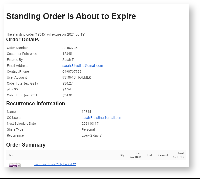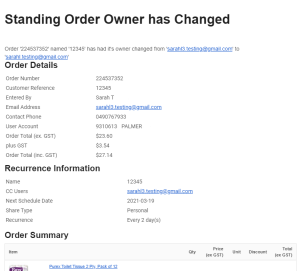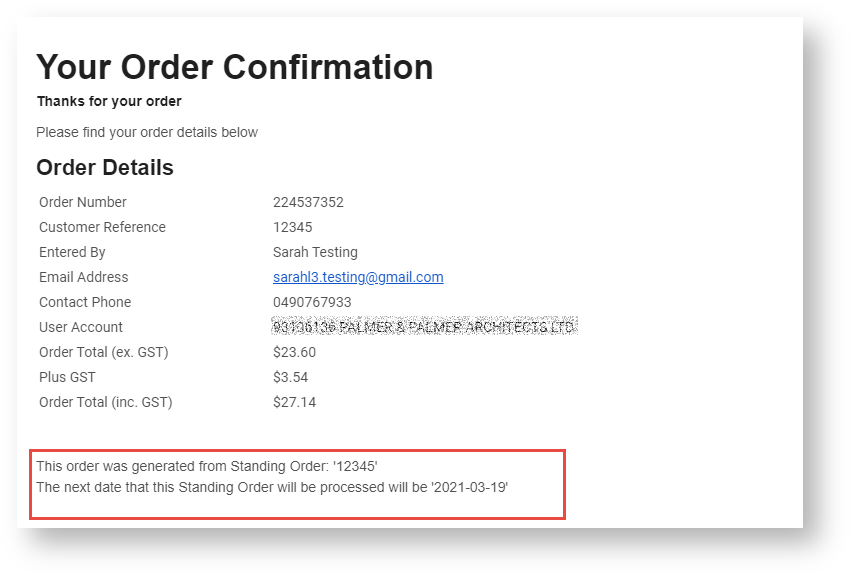Step-by-step guide
1. Configure Standing Orders
- Go to Settings → Settings → Feature Management → Orders & Checkout → Standing Orders
- For the Standing Order Feature Settings page, click Configure.
Enable Standing Orders: leave OFF unless you want to enable Standing Orders for all Users (apart from any Overrides). Use Overrides to enable/disable for specific Customer/Role/User/Customer User. TIP - Businesses would not usually permit all users to create or be responsible for standing orders.
NOTE - If you're trying to disable an enabled user or customer user and the system will not allow it, it is likely that the user is the owner (usually the creator) of a current standing order.
Place Standing Orders When Over Order Limit: determines whether to place a repeat order with re-priced items or other adjustments that will push the order total over a user's budget limit. (Only if the Customer account uses User Order Limits.)
Toggle ON: the order is placed (but future repeat orders will require approval if the limit is still exceeded).
Toggle OFF: the order is not placed and will be skipped (and future ones will require approval if the limit is still exceeded).- Place Standing Orders When Over Customer Budget: determines whether to place a repeat order with re-priced items or other adjustments that will push the order total over the Customer account's budget. NOTE - Use the Override feature if this varies from customer to customer.
Toggle ON: the order is placed (but future repeat orders cannot be placed until the budget limit is available)
Toggle OFF: the order is not placed (and future ones cannot be placed until the budget limit is available)
* (The Owner (usually creator) of the Standing Order will receive a notification email for this event.) - Can Administer Standing Orders: click Overrides to set the Roles or Users that will be Standing Order Administrators. This special role can view, edit and delete all standing orders in their Customer account. Enabling/disabling this role can also be done for a specific user on the Edit User page.
- Number of Days Before Expiry to Notify Users: enter the number of days before a standing order expires for an alert to be emailed to the Owner and any cc'ed Users. Default: 14 days; TIP - To turn off this notification, set the number to '0'. (For this function to work, the Standing Order Days Expiry Notifier task must be scheduled. See: Task Scheduler.)
- Standing Order Email Due Days: enter the number of days before a standing order is to be placed for an alert to be emailed to the Owner and any cc'ed Users. Default: 5 days;
Notification Email Address, enter one or more internal (staff) email addresses to receive standing order notifications. Multiple email addresses must be semi-colon separated.
Notification about Inactive User Owner
If the Owner of a 'shared' standing order has been deactivated, these recipients will receive a notification that a 'shared' standing order exists for a deactivated user.
- Click Save or Save & Exit otherwise your changes including any overrides will not be saved.
2. Add Configure for Schedule Standing Order Button Widget
This widget renders the Schedule Standing Order button on the Checkout page. This lets the user start a standing order.
- Go to the Checkout template (Content → Content → Pages & Templates → Checkout).
- Go to the zone where you want this button added. TIP - A good place is the bottom of the Step2 zone.
- (optional) Edit the button text in the widget if needed. See: Configure for Schedule for Standing Orders Button Widget
3. Edit Standing Order widgets
When Standing Orders is enabled, standing order widgets are automatically added in various templates. These widgets render text, buttons and messages in Standing Orders templates. Text and messages can be edited.
(i) Schedule Standing Order Panel Widget
Location: Schedule Standing Order template (Content → Pages & Templates → Orders).
Purpose: Renders the text and messaging on the Schedule Standing Orders panel.
What you can do:
- Enable/disable force users to accept the Standing Order Terms and Conditions before they can save standing orders.
- Edit Terms and Conditions text and related messaging. NOTE - If the Terms and Conditions textbox is empty, the T&C section is not displayed to the User.
Guide to widget: Schedule Standing Order Panel Widget
(ii) Standing Order Schedule Information Widget
Location: Standing Order Summary template (Content → Pages & Templates → Orders).
Purpose: Renders the heading text of the recurrence order details for the order's detail screen and in emails that include recurrence details.
What you can do: edit heading. (Click here for help on this widget.)
Guide: Standing Order Schedule Information Widget
(iii) Configure Schedule for Standing Order Button Widget
Location: Checkout template (Content → Content → Pages & Templates → Checkout)
Purpose: renders the button that lets a user create the Standing Order schedule
What you can do: edit the button label
Guide: Configure for Schedule for Standing Orders Button Widget
(iv) Cart Buttons Widget
Location: Cart template (Content → Content → Pages & Templates → Checkout → Cart)
Purpose: Renders the button that lets the user start a standing order. The button displays only for users enabled for Standing Orders. (TIP - The Widget includes buttons for other functions as well.)
What you can do: edit the text and icon displayed on the button.
Guide: Cart Buttons Widget
4. Create Scheduler Task for Standing Orders Emails
Whenever a repeat order is processed and placed, the usual order confirmation emails (and any approval-related ones) are sent to users. In addition, certain standing order events will trigger notification emails. Scheduler Maintenance tasks must be created to check for and send these emails. See: Standing Order Emails
Standing Orders scheduled tasks:
- Standing Order Due Days Notifier: schedules the recurring order due soon email to be sent to the Owner and any other cc'ed Users (MANDATORY if order placed due soon emails are to be sent),
- Standing Order Expiring Soon Notifier: schedules expiry warning soon email to be sent to the Owner and any other cc'ed Users (MANDATORY if standing order expiring soon emails are to be sent),
- Standing Order Approver Notifier: schedules emails for standing order approval events (ONLY IF ORDER APPROVALS IS ACTIVE ON YOUR SITE)
- Standing Order Task: schedules all other standing order-related emails. (MANDATORY)
- Logged in on your website, go to Settings → Scheduler Task Maintenance.
- Select New.
- Begin the task: select to send the email 'At Startup' or 'On a Schedule'. If on a schedule, this will be set up during the task.
- Name: enter a descriptive name for this task.
- Active: tick checkbox if this task is to be active immediately after saving.
- Task: select one of the Standing Order tasks from the list.
- Schedule: enter its details, e.g., start/end dates and times. NOTE - If task type is 'On a Schedule', enter the frequency details.
- Error Notification CC Emails: enter the email address to receive failed send error notifications.
- Click Save.
- Repeat (steps 2-9) for other required scheduled tasks.
5. Edit Standing Order Emails
You can edit standing order email templates. Go to Content → Emails.
Standing order approval emails
The Standing Order Approver Notifier task will trigger the following emails:
Standing Order Awaiting Approval Email: notifies a user they are the approver for a standing order. (See Approver Functions for more information.)
Standing Order Awaiting Approver Selection Email: notifies the standing order Creator/Owner they need to select an approver. Email content can be edited or customised in various widgets in the Standing Order Awaiting Approver Selection Email template.
Emails for Standing Order Due and Expiry
The Standing Order Due Days Notifier task will trigger the following email:
- Standing Order Due Days Notification Email: notifies the current owner and any cc'ed Users to remind them that a recurring order is due to be placed in 'X' number of days. Email content can be edited in the Standing Orders Due Days Widget.
The Standing Order Expiry Soon Notifier task will trigger the following email:
Standing Order Expiry Email: notifies current owner and any cc'ed Users 'X' number of days before the standing order expires. The number of days is set in standing order settings. Email content can be edited in the Standing Order Expiry Widget.
All other emails for Standing Order
The Standing Order Task will trigger the following emails:
Standing Order Changed Ownership Email: notifies old owner, new Owner, and any cc'ed Users when ownership of a standing order is transferred to another user. Email content can be edited in various widgets in the Standing Order Expiry Email template.
- Standing Order No Products Email: notifies the current Owner of a standing order and any cc'ed users that a recurring order was not placed because of product unavailability.) Email content can be edited in various widgets in the Standing Order No Products email template.
Example:
- Standing Order Over Budget Email: notifies the current Owner of a standing order and any cc'ed Users that due to re-pricing or re-adjustment to a standing order, the next processed order will be over budget. Email content can be edited in various widgets in the Standing Order Over Budget email template.
6. Add Standing Order Messages in Order Email Templates
Every time a recurring order is placed, the usual order notification emails are automatically sent. The most common would be the order confirmation email.
Add these widgets to order email templates to insert standing order messages.
- Standing Order Message Widget - when applicable, inserts one or more of these messages: the order is from a standing order, the next scheduled recurring order date, the order is the last scheduled order, the order needs approval.
- Standing Order Removed Lines Widget - inserts the message that one or more order lines (products) were removed from this recurrent order due to unavailability
A message will display only for placed orders from standing orders and when relevant to the order.
Example:
To add these widgets,
- Go to Content → Emails and find the required email template, e.g., Order Confirmation Email
- Go to the zone to add the message, and click Add Widget.
- Find the Standing Order Message Widget, and click Add Widget.
- Find the Standing Order Removed Lines Widget and click Add Widget.
- (Optional) Edit the messages in the widgets and change their locations.
- (Optional) Send a test email to view the email content. Click Test Email in the top right corner of the screen.
Standing Orders Reporting (option)
NOTE - standing order reports are typically custom-designed and implemented to suit your business. Please consult Commerce Vision to discuss any standing order reporting requirements.
Standing order reports can be created to track standing order information such as the following:
- Current list of standing orders
- Standing orders for closed accounts
- Standing orders for inactive users.
Additional Information
| Minimum Version Requirements |
|
|---|---|
| Prerequisites |
|
| Self Configurable |
|
| Business Function |
|
| BPD Only? |
|
| B2B/B2C/Both |
|
| Third Party Costs |
|
Related Resources











